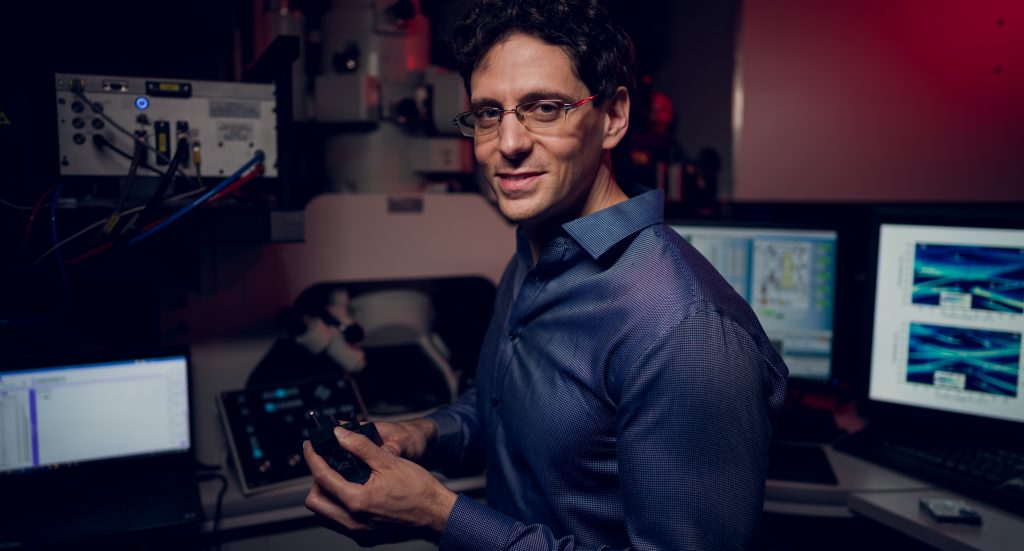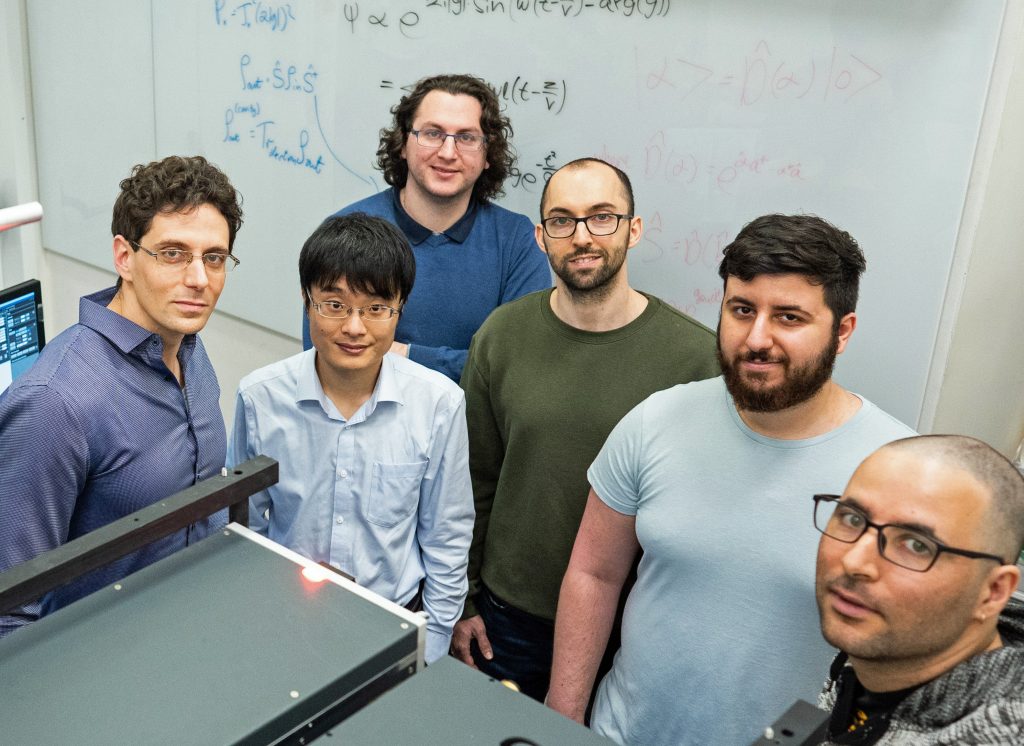A Unique Quantum Microscope
One-of-a-kind Microscope Enables Breakthrough in Quantum Science
Breakthrough Quantum Microscope: Prof. Ido Kaminer and team have made a dramatic breakthrough in the field of quantum science: a quantum microscope that records the flow of light, enabling the direct observation of light trapped inside a photonic crystal.
Their research, “Coherent Interaction Between Free Electrons and a Photonic Cavity,” was published in Nature. All the experiments were performed using a unique ultrafast transmission electron microscope at Technion. The microscope is the latest and most versatile of a handful that exists in the scientific world.
“We have developed an electron microscope that produces, what is in many respects, the best near- field optical microscopy in the world. Using our microscope, we can change the color and angle of light that illuminates any sample of nano materials and map their interactions with electrons, as we demonstrated with photonic crystals,” explained Kaminer. “This is the first time we can actually see the dynamics of light while it is trapped in nano materials, rather than relying on computer simulations,” added Dr. Kangpeng Wang, a postdoc in the group and first author on the paper.

Prof. Ido Kaminer
All of the experiments were performed on the ultrafast transmission electron microscope in the Robert and Ruth Magid Electron Beam Quantum Dynamics Laboratory headed by Kaminer. Prof. Ido Kaminer is a faculty member in the Andrew and Erna Viterbi Faculty of Electrical Engineering and the Solid State Institute. Kaminer is affiliated with the Helen Diller Quantum Center and the Russell Berrie Nanotechology Institute. The research team also includes: Dr. Kangpeng Wang, Raphael Dahan, Michael Shentcis, Dr. Yaron Kauffmann, Adi Ben-Hayun, Ori Reinhardt, and Shai Tsesses.
Far-reaching Applications
This breakthrough is likely to have an impact on numerous potential applications, including the design of new quantum materials for storing quantum bits with greater stability. Similarly, it can help improve the sharpness of colors on cell phones and other kinds of screens.
“It will have an even wider impact once we investigate more advanced nano/quantum materials. We have an extremely high-resolution microscope and we are starting to explore the next stages,” Prof. Kaminer elaborated. “For example, the most advanced screens in the world today use QLED technology based on quantum dots, making it possible to control color contrast at a much higher definition. The challenge is how to improve the quality of these tiny quantum dots on large surfaces and make them more uniform. This will enhance screen resolution and color contrast even more than current technologies enable.”

Photo taken by the quantum microscope: the light pattern captured in a photonic crystal
Courtesy of Nature, Prof. Ido Kaminer
A New Kind of Quantum Matter
The ultrafast transmission electron microscope in Prof. Kaminer’s AdQuanta lab has an acceleration voltage that varies from 40 kV to 200 kV (accelerates electrons to 30-70% the speed of light), and a laser system with sub 100 femtosecond pulses at 40 Watts. The ultrafast electron transmission microscope is a femtosecond pump-probe setup that uses light pulses for exciting the sample and electron pulses for probing the sample’s transient state. These electron pulses penetrate the sample and image it. The inclusion of multidimensional capabilities in one setup is extremely useful for full characterization of nano-scale objects.
At the heart of the breakthrough lies the fact that advances in the research of ultrafast free-electron-light interactions have introduced a new kind of quantum matter – quantum free-electron ‘wavepackets.’ In the past, quantum electrodynamics (QED) studied the interaction of quantum matter with cavity modes of light which has been crucial in the development of the underlying physics that constitutes the infrastructure of quantum technologies. However, all experiments to date have only focused on light interacting with bound-electron systems – such as atoms, quantum dots, and quantum circuits – which are significantly limited in their fixed energy states, spectral range, and selection rules. Quantum free-electron wave packets, however, have no such limits. Despite multiple theoretical predictions of exciting new cavity effects with free electrons, no photonic cavity effect has previously been observed for free electrons, due to fundamental limits on the strength and duration of the interaction.
Prof. Kaminer and team have developed an experimental platform for the multidimensional study of free-electron interactions with photons at the nanoscale. Their unique microscope achieved record near-field optical maps by utilizing the quantum nature of electrons, which were verified by observing Rabi oscillations of the electron spectrum that cannot be explained by pure classical theory.
More efficient free-electron-cavity-photon interactions could allow strong coupling, photon quantum state synthesis, and novel quantum nonlinear phenomena. The field of electron microscopy and additional areas of free-electron physics may gain from the fusion with photonic cavities, enabling low-dose, ultrafast electron microscopy of soft matter or other beam-sensitive materials.
Prof. Kaminer hopes that the microscope will serve the wider Technion community in other research fields. “I would like to nurture interdisciplinary collaboration,” he noted.

(l-r) Prof. Ido Kaminer, Dr. Kangpeng Wang, Research team members, Research Engineer Raphael Dahan (far right)
Prof. Ido Kaminer completed his Bachelor’s degree in Electrical Engineering and Physics at Technion as part of the Psagot reserves program and the Rothschild Technion Excellence Program. He completed his MSc and PhD under the supervision of Dist. Prof. Moti Segev. Kaminer went on to do a postdoctoral fellowship at MIT, where he was hosted by Prof. Marin Soljačić and Dist. Prof. John Joannopoulos, with the support of the Marie Curie Fellowship, the Rothschild Fellowship, and the MIT-Technion Fellowship. In 2018, Kaminer joined the faculty of the Technion Viterbi Faculty of Electrical Engineering.
Over the years, Prof. Kaminer has received numerous additional awards and grants, including the Israeli Physics Society Graduate Student Award, Outstanding Doctoral Thesis Award in Laser Science by the American Physics Society, Azrieli Faculty Fellowship and an ERC Starter Grant on behalf of the European Research Council.
Dr. Kangpeng Wang is a Lady Davis Postdoctoral Fellow at Technion. The research was also supported by the Israel Academy of Sciences and Humanities, which awarded the Adams Scholarship to Shai Tsesses. Prof. Ido Kaminer is a member of the Helen Diller Quantum Center and the Russell Berrie Nanotechology Institute. All of the experiments were performed in the Robert and Ruth Magid Electron Beam Quantum Dynamics Laboratory located in the Electron Microscopy Center in the Faculty of Materials Science and Engineering.
Click here for the paper in Nature


